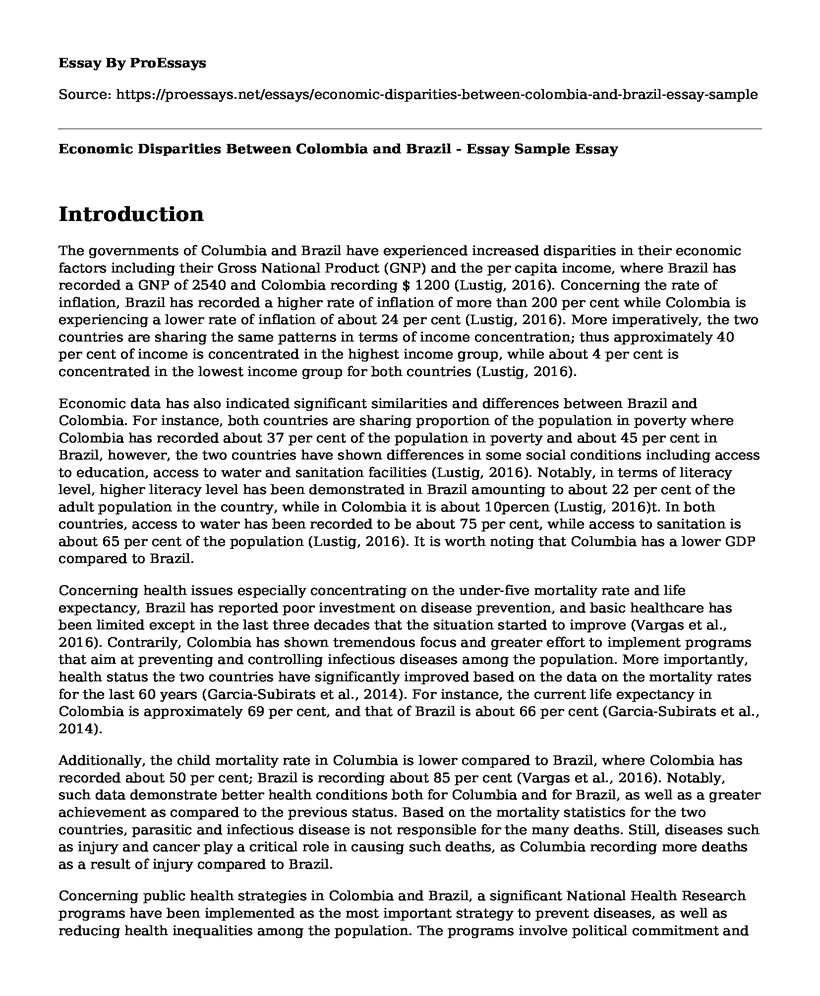Introduction
The governments of Columbia and Brazil have experienced increased disparities in their economic factors including their Gross National Product (GNP) and the per capita income, where Brazil has recorded a GNP of 2540 and Colombia recording $ 1200 (Lustig, 2016). Concerning the rate of inflation, Brazil has recorded a higher rate of inflation of more than 200 per cent while Colombia is experiencing a lower rate of inflation of about 24 per cent (Lustig, 2016). More imperatively, the two countries are sharing the same patterns in terms of income concentration; thus approximately 40 per cent of income is concentrated in the highest income group, while about 4 per cent is concentrated in the lowest income group for both countries (Lustig, 2016).
Economic data has also indicated significant similarities and differences between Brazil and Colombia. For instance, both countries are sharing proportion of the population in poverty where Colombia has recorded about 37 per cent of the population in poverty and about 45 per cent in Brazil, however, the two countries have shown differences in some social conditions including access to education, access to water and sanitation facilities (Lustig, 2016). Notably, in terms of literacy level, higher literacy level has been demonstrated in Brazil amounting to about 22 per cent of the adult population in the country, while in Colombia it is about 10percen (Lustig, 2016)t. In both countries, access to water has been recorded to be about 75 per cent, while access to sanitation is about 65 per cent of the population (Lustig, 2016). It is worth noting that Columbia has a lower GDP compared to Brazil.
Concerning health issues especially concentrating on the under-five mortality rate and life expectancy, Brazil has reported poor investment on disease prevention, and basic healthcare has been limited except in the last three decades that the situation started to improve (Vargas et al., 2016). Contrarily, Colombia has shown tremendous focus and greater effort to implement programs that aim at preventing and controlling infectious diseases among the population. More importantly, health status the two countries have significantly improved based on the data on the mortality rates for the last 60 years (Garcia-Subirats et al., 2014). For instance, the current life expectancy in Colombia is approximately 69 per cent, and that of Brazil is about 66 per cent (Garcia-Subirats et al., 2014).
Additionally, the child mortality rate in Columbia is lower compared to Brazil, where Colombia has recorded about 50 per cent; Brazil is recording about 85 per cent (Vargas et al., 2016). Notably, such data demonstrate better health conditions both for Columbia and for Brazil, as well as a greater achievement as compared to the previous status. Based on the mortality statistics for the two countries, parasitic and infectious disease is not responsible for the many deaths. Still, diseases such as injury and cancer play a critical role in causing such deaths, as Columbia recording more deaths as a result of injury compared to Brazil.
Concerning public health strategies in Colombia and Brazil, a significant National Health Research programs have been implemented as the most important strategy to prevent diseases, as well as reducing health inequalities among the population. The programs involve political commitment and the government in the two countries ensures financial support for the health sector that helps in successful research. Another strategy is the application of a new technology in healthcare which includes therapeutic and diagnostic procedures (Vargas et al., 2016). More imperatively, the integration of technology in healthcare, as well as the rapid advancement in technology both in Brazil and Colombia, has adversely affected healthcare cost. Finally, in both countries, there is a huge amount of health information, and a small portion of it is utilized while making decisions concerning health issues.
References
Garcia-Subirats, I., Vargas, I., Mogollon-Perez, A. S., De Paepe, P., Da Silva, M. R. F., Unger, J. P., ... & Vazquez, M. L. (2014). Inequities in access to health care in different health systems: a study in municipalities of central Colombia and north-eastern Brazil. International journal for equity in health, 13(1), 10. https://equityhealthj.biomedcentral.com/articles/10.1186/1475-9276-13-10
Lustig, N. (2016). Inequality and Fiscal Redistribution in Middle Income Countries: Brazil, Chile, Colombia, Indonesia, Mexico, Peru and South Africa. Journal of Globalization and Development, 7(1), 17-60. https://www.degruyter.com/view/j/jgd.2016.7.issue-1/jgd-2016-0015/jgd-2016-0015.xml
Vargas, I., Mogollon-Perez, A. S., De Paepe, P., Ferreira da Silva, M. R., Unger, J. P., & Vazquez, M. L. (2016). Barriers to healthcare coordination in market-based and decentralized public health systems: a qualitative study in healthcare networks of Colombia and Brazil. Health policy and planning, 31(6), 736-748. https://academic.oup.com/heapol/article/31/6/736/1749789
Cite this page
Economic Disparities Between Colombia and Brazil - Essay Sample. (2023, Mar 20). Retrieved from https://proessays.net/essays/economic-disparities-between-colombia-and-brazil-essay-sample
If you are the original author of this essay and no longer wish to have it published on the ProEssays website, please click below to request its removal:
- Assignment Example on Microeconomics
- Essay Sample on Private Transportation and Fleet Management
- Essay Sample on Obamacare and Trump
- Essay Sample on Underemployment Crisis: Exploring the Benefits of Self-Employment
- Essay Example on US: A Superpower Promoting Global Democracy
- Essay Sample on Barak Obama's ACA: Wider Access to Healthcare or Controversy?
- Trump's Deep State Conspiracy Theory: Who Does It Help? - Essay Sample







